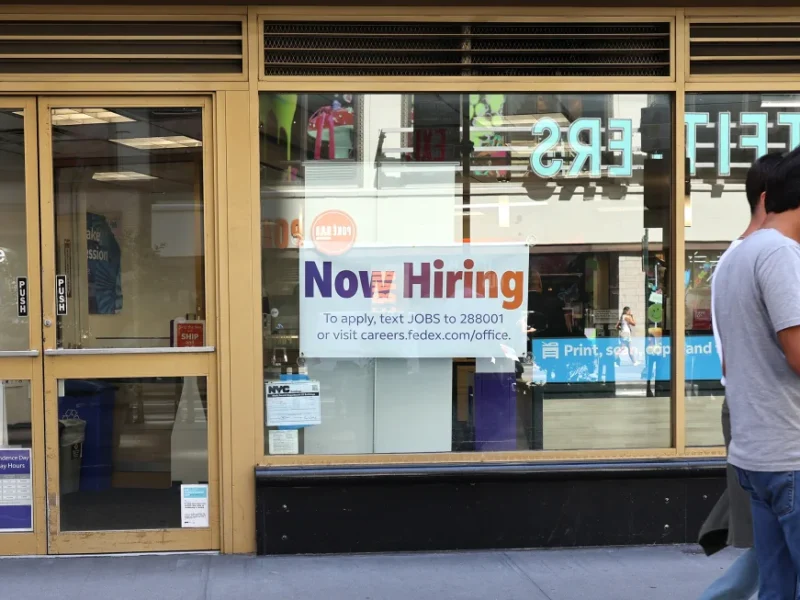The pandemic caused significant disruption in the US job market, but after four years, conditions appear to have stabilized.
Although monthly job gains have slowed, they remain steady. The balance between labor supply and demand has improved, there hasn’t been a wave of layoffs, and the overall economy and consumer spending are doing well.
Most indicators suggest the job market is no longer overheated and can sustain a new norm of steady but slower growth.
Federal Reserve Chair Jerome Powell echoed this sentiment, stating that various indicators show the labor market has returned to pre-pandemic conditions: strong, but not overheated.
Economists predict that the July jobs report will show a net gain of 175,000 jobs, slightly below the average of the past three months, with the unemployment rate holding steady at 4.1%, according to FactSet consensus estimates.
Nick Bunker, director of North American economic research at Indeed, told CNN, “This is a labor market that’s otherwise moderated.”
However, Powell also mentioned the increased vulnerability, noting that “downside risks are real now.”
Nancy Vanden Houten, senior economist at Oxford Economics, warned that the labor market is more susceptible to a rapid decline if an unexpected shock occurs or if interest rates remain high for much longer. She emphasized the need for the Federal Reserve to prevent a scenario where rising unemployment triggers a negative cycle of job losses and income reduction.
The Fed isn’t expected to cut rates until at least September, but the upcoming jobs report will offer crucial insights into the labor market’s sustainability.
How the unemployment rate moves?
Hiring activity has slowed down, job postings have decreased, and data on unemployment insurance claims show that more people are unemployed and staying jobless for longer periods.
Last week, initial applications for jobless benefits rose to around 249,000, the highest level since August of the previous year, according to data from the Department of Labor. Additionally, continuing claims, which are made by individuals who have been receiving unemployment benefits for at least a week, reached 1.877 million, the highest number since November 2021.
The unemployment rate increased to 4.1% last month, marking the first time it has been above 4% since November 2021.
Despite these trends, economists believe the situation might not be as dire as it seems, at least for now. The key reason is that layoffs have not surged. In July, announced job cuts fell by 47% compared to June, totaling 25,885, the lowest monthly figure of the year and the smallest since last July.
A further rise in the unemployment rate could potentially impact economic growth, especially if layoffs increase, according to Madhavi Bokil, a senior vice president at Moody’s Ratings. For now, the increase in the unemployment rate might mainly reflect more people entering the labor force, as suggested by Indeed’s Bunker. Monitoring data on permanent job losses will be important moving forward.
How many people are working?
The labor force participation rate and the employment-to-population ratio are crucial indicators that suggest the labor market remains strong.
For workers aged 25 to 54, the employment-to-population ratio was steady at 80.8% in June, close to the 23-year peak of 80.9% reached last year, according to Bureau of Labor Statistics (BLS) data. Similarly, the prime-age labor force participation rate remained high at 83.7%, the best in 23 years.
Overall labor force participation increased to 62.6%, showing improvement since the pandemic downturn, though growth is limited by an aging population.
Elise Gould, a senior economist at the Economic Policy Institute, noted that a strong employment-to-population ratio indicates a healthy labor market. She explained that the unemployment rate can fluctuate due to various factors, including job seekers, and that an aging population and rising retirement rates could soften participation.
Additionally, examining the impact of foreign-born and native-born workers can shed light on how immigration affects the labor market and whether the participation rate for native-born workers continues to improve. Bunker pointed out that while increased immigration has contributed to the labor market’s stability, it is not the sole factor.
Whether people are working fewer hours
Employers, particularly in the restaurant industry, are increasingly hiring part-time workers, partly due to consumers reducing spending in response to high prices. However, the proportion of workers who are only able to find part-time work for economic reasons is similar to levels seen in 2019 and remains below historic highs. This suggests that while part-time work is more in demand, the overall issue of underemployment is not as severe as in past downturns.
The temporary help services sector has traditionally been a key indicator of future employment trends. When companies are expanding, they often hire temporary workers as a precursor to full-time positions, while economic downturns usually lead to a reduction in temp jobs first.
However, this sector has experienced a significant decline in jobs over the past two years without a corresponding severe drop in the overall labor market. Bunker described the temporary help services industry as the “Boy who cried wolf,” noting that despite its warnings of trouble, no major downturn has materialized.
Are wage gains continuing to slow?
Pay growth is continuing to slow down, reducing concerns about a wage-price spiral. Recent Employment Cost Index data revealed that wages and benefits increased by just 0.9% in the second quarter, the slowest quarterly rate in three years. On an annual basis, compensation costs also decelerated to 4.1%.
Although the average hourly earnings figure from the jobs report is considered less stable and comprehensive compared to the ECI, a slowdown is anticipated there as well, with expectations of a decrease from 3.9% to 3.7%, according to FactSet.
Julia Pollak, chief economist at ZipRecruiter, noted that if average hourly earnings growth speeds up, it might not be a major concern. She mentioned that the impact of Hurricane Beryl could distort the figures, as a reduction in average hours worked due to the hurricane might artificially inflate wage growth. Thus, she advises being cautious about any reported increase in wage growth, given that other indicators suggest a cooling trend. This is supported by the ADP employment report, which showed that wage growth for both current employees and job switchers is at its slowest in three years.
Which industries are hiring
The US job market is currently experiencing a notable period of growth, marking the fifth-longest employment expansion on record. However, much of this growth is concentrated in just a few sectors: healthcare, government, and, until recently, leisure and hospitality.
This concentration means that while overall employment figures are strong, the gains are not evenly distributed. This situation creates what’s described as a “rolling recession,” where different sectors face downturns and recoveries at different times.
Pollak explained that the strong performance in government and healthcare is inflating the overall numbers, which might not reflect the challenges faced by other sectors. This discrepancy can contribute to a perception of economic difficulty despite positive aggregate statistics. Many people are not employed in these booming sectors and may struggle to transition into them, highlighting the gap between overall job growth and individual experiences.
The Bureau of Labor Statistics (BLS) tracks how employment changes are spread across various industries. Recently, these measures have shown a slight increase in broad-based job growth, as indicated by diffusion indexes, which track whether more industries are experiencing employment gains or losses.











